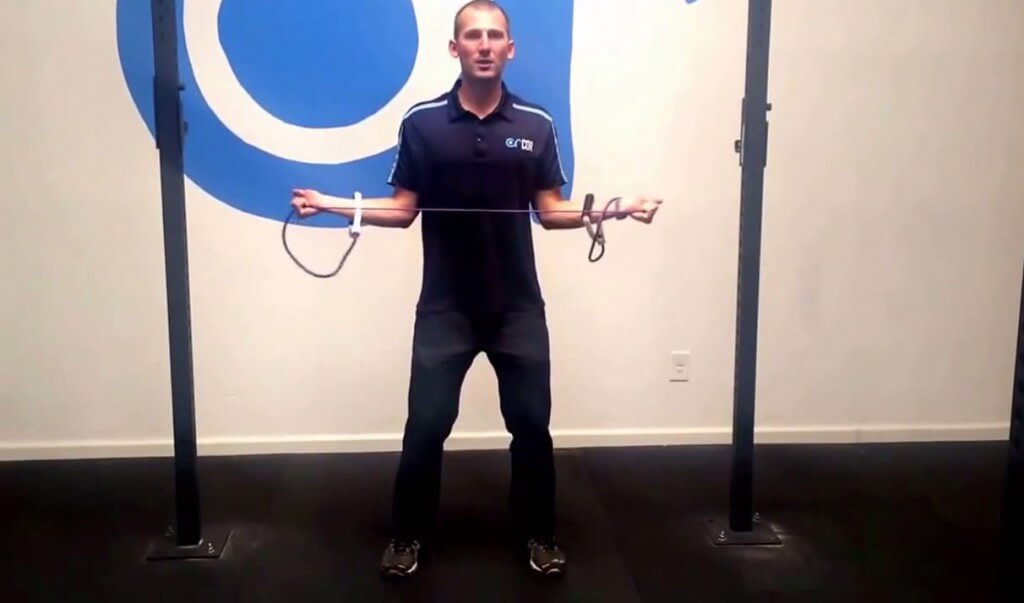Swimmer’s Shoulder Off-season Guide

By Dr. G. John Mullen, Swimming World Contributor.
The swimming “off-season” or spring break is around the corner for many in the swimming community. Although, not everyone is having a break (sorry high school swimmers whose swim season has just started), this period is a great opportunity to improve cranky shoulders!
Yes, I know I talk about cranky swimmer’s shoulders a lot, but it is a serious issue and one which is even under reported. Too often swimmer’s assume shoulder pain is normal and repeat “no pain, no gain”. This mindset can feed into further problems, injuries, and disinterest in the sport.
A study in 2013 found the following:
“Overall, 85 percent of high school-aged club swimmers reported mild shoulder pain in the past year, 61 percent reported moderate shoulder pain, and 21 percent reported severe shoulder pain. Of these, only 14 percent had been to a physician. Seventy-three percent report using pain medication to manage their shoulder pain and 47 percent used it regularly, as in one or more times per week (Hibberd 2013).”
Not seeking treatment and masking pain with pain medication isn’t a viable long-term solution. If you are entering your off-season, consider these 6 tips for swimmer’s shoulder during the “off-season”.
6 “Off-Season” Swimmer’s Shoulder Tips
1. Balance the Unbalanced with Strengthening
Swimming creates imbalances early in a swimmer’s career. Each time a swimmer creates a catch in the water, they are performing an aggressive internal rotation of the shoulder (and most likely an uncontrolled protraction of the shoulder blade). Creating a simple off-season training program focusing on improving the imbalances is a great place to start! Just make sure you are not just flying through through the exercises and are actually contracting the correct muscles!
Too often swimmers will only perform band exercises, with incorrect muscular contraction. Make sure you are activating the correct muscles and building the “mind-muscle” connection, the neural connection!
Now, every swimmer is different, so exact guidelines are not possible, but overall, I suggest performing ~2 – 3 scapular retraction exercises, combined with 2 – 3 external rotation exercises for a well balanced strengthening program.
Below are a few examples:
Scapular Retraction Exercises
If you want to learn more about shoulder pain and if it is on the rise, check this out!
2. Fix Your Overcompensated Muscles
Swimming doesn’t only create imbalances via weakness, but also tightness. In fact, tight muscles can cause weakness as well! Even minimal tightness can alter performance or at least bioemechanics at the end of practice. Here are a few helpful areas to work on:
3. Don’t Forget to Improve Your Spine…
It is easy to over stress the importance of the shoulder during prevention or rehabilitation, but often the neck and spine play a vital role! The neck is often too far forward in swimmer’s posture [don’t forget to checkout this piece].
Here are a few tips to improve your spine!
4. Perform Post-Season Needs Analysis and Plan for Improvement
The post-season is a great time for assessment, evaluation, and planning. Too often swimmers will perform their taper meet, then simply assume the training either worked, didn’t, or perhaps they hit/missed their taper. However, a more detailed analysis can provide much more beneficial information. For example, analyzing your race, race strategy, biomechanics, and fatigue points can provide great benefit for improving yourself at the next big meet.
This can done with your coach or online services. Swimming Science provides a very detailed analysis of your race, comparing it to Olympic medalist and providing specifics for improvement.
You may wonder how this influences shoulder stress, but imagine, if your race strategy results in fatiguing prematurely, you’ll have improper biomechanics for a longer period of time and increase your risk of injury. Also, race footage provides essential information of a swimmer’s technique at a true maximal effort. Plan, train, analyze, set a plan for improvement, swim and repeat.
5. Rest/Meditate/Incantation
Sometimes simply taking rest is the correct remedy for the shoulders. However, this laid back strategy often isn’t enough. Beginning a daily meditation or incantation practice can reduce stress and anxiety, areas which can foster or worsen orthopedic pain. Beginning these practices is great in the off-season when swimmer’s have more time on their hands.
6. Perform an Off-Season Activity
For some, particularly youth swimmers, performing a complimentary or other activity can help improve imbalances, reduce mental stress, and be fun! When determining a secondary activity, remember anything is better than nothing! However, doing sports with similar demands (water polo) can exacerbate imbalances. Try and think of other activities which can challenge the swimmer and improve muscular imbalances.
Consider some of these:
- Guided resistance training
- Rock climbing
- Karate
- Ballet
- Play outside
- Do something
As a swimming community, we can’t ignore injury risks. We know many swimmers will have shoulder pain and injury within the sport, this is the risk within the sport. Like all sports, risk exists, therefore addressing aches and pains early and providing proper injury prevention is key for elite performance and long-term success. Stay healthy this “off-season” and make improvements at the same time!
For more tips, check out the COR Swimmer’s Shoulder System! For other tips on improving your swimming, check this out.
All commentaries are the opinion of the author and do not necessarily reflect the views of Swimming World Magazine nor its staff. All swimming and dryland training and instruction should be performed under the supervision of a qualified coach or instructor, and in circumstances that ensure the safety of participants.




Muscle overlap, work muscles shoulders/arms from all angles with dumbbells, cables & Indian clubs, doorway stretches
Kaitlyn Miller Kassandra Miller
Ilse
Amy Williamson
Douglas Mclean -might be useful x
Sergio Daniel Fonseca Rojas
Helena Blumenau
Chris Zalinski